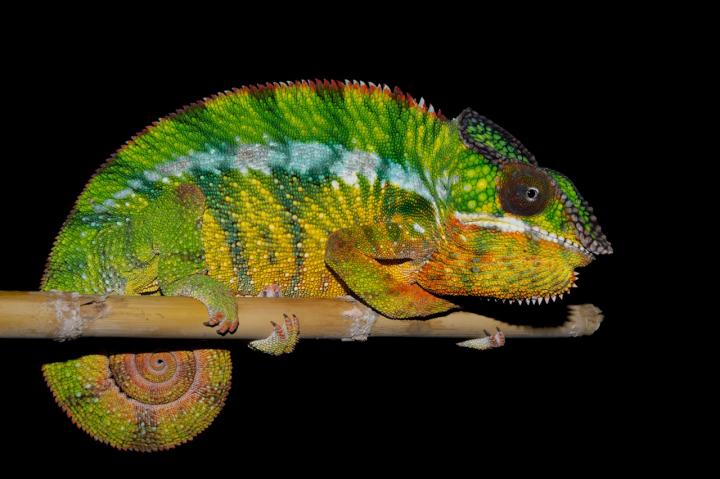Biodiversity: 11 new species come to light in Madagascar

Shown here is a panther chameleon. Credit: © Michel Milinkovitch
Madagascar is home to extraordinary biodiversity, but in the past few decades, the island's forests and associated biodiversity have been under greater attack than ever. Rapid deforestation is affecting the biotopes of hundreds of species, including the panther chameleon, a species with spectacular intra-specific colour variation. A new study by Michel Milinkovitch, professor of genetics, evolution, and biophysics at the University of Geneva (UNIGE), led in close collaboration with colleagues in Madagascar, reveals that this charismatic reptilian species, which is only found in Madagascar, is actually composed of eleven different species. The results of their research appear in the latest issue of the Molecular Ecology journal. They also discuss the urgent need to protect Madagascar's habitats.
In collaboration with professor Achille Raselimanana of the University of Antananarivo, researchers from the Department of Genetics and Evolution in the UNIGE Faculty of Sciences, led by Michel Milinkovitch, sought to find the genetic keys behind panther chameleon's incredible colour palette. Their analyses, performed on site in Madagascar, reveal the presence of 11 rather than a single species.
A Talkative Drop of Blood
It took two expeditions led from East to West for the scientists to collect a drop of blood from each of 324 individuals and document them through colour photographs. The DNA (mitochondrial and nuclear) of each of the specimens were sequenced and analysed in the laboratory according to the hypothesis that a chameleon's dominant colour might be related to the geographic zone where it is found. Most importantly, the genetic material indicated strong genetic structure among geographically-restricted lineages, revealing very low interbreeding among populations.
A Key for Turning Genetics into Color
The mathematical analyses of the 324 colour photographs demonstrated that subtle colour patterns could efficiently predict assignment of chameleon individuals to their corresponding genetic lineage, confirming that many of the geographical populations might need to be considered separated species. The scientists then simplified their analyses of the colour diversity into a classification key, which allows to link most chameleons to their corresponding species using only the naked eye. This case of hidden speciation confirms a major characteristic of Madagascar: it is amongst the most diverse places for life on Earth; a biodiversity hotspot.
Madagascar, Unique but Precarious Conservatory
Each of the new chameleon species requires individual management, given that they each constitute a different part of the biodiversity of the whole. The visual classification key devised by the researchers could assist local biologists and trade managers to avoid local population over-harvesting. The task of biodiversity management is daunting because of the widespread destruction of the forest habitat for agricultural practices as well as for firewood and charcoal production by populations with very low living standards. These human activities threaten the survival of 400 species of reptile, 300 species of amphibians, 300 species of birds, 15,000 species of plants and countless species of invertebrates. In addition, approximately 80 to 90% of all living species found in Madagascar are endemic, meaning they exist nowhere else on earth.
Given the charismatic nature of chameleons, Milinkovitch hopes that, beside a better understanding of the genetic basis of colour variation in chameleons, his collaborative study with his Malagasy colleagues will help his colleague, Professor Raselimanana, to continue his difficult enterprise: raising awareness for the staggering but fragile biodiversity hosted by Madagascar.
Media Contact
All latest news from the category: Life Sciences and Chemistry
Articles and reports from the Life Sciences and chemistry area deal with applied and basic research into modern biology, chemistry and human medicine.
Valuable information can be found on a range of life sciences fields including bacteriology, biochemistry, bionics, bioinformatics, biophysics, biotechnology, genetics, geobotany, human biology, marine biology, microbiology, molecular biology, cellular biology, zoology, bioinorganic chemistry, microchemistry and environmental chemistry.
Newest articles

Innovative vortex beam technology
…unleashes ultra-secure, high-capacity data transmission. Scientists have developed a breakthrough optical technology that could dramatically enhance the capacity and security of data transmission (Fig. 1). By utilizing a new type…

Tiny dancers: Scientists synchronise bacterial motion
Researchers at TU Delft have discovered that E. coli bacteria can synchronise their movements, creating order in seemingly random biological systems. By trapping individual bacteria in micro-engineered circular cavities and…

Primary investigation on ram-rotor detonation engine
Detonation is a supersonic combustion wave, characterized by a shock wave driven by the energy release from closely coupled chemical reactions. It is a typical form of pressure gain combustion,…



